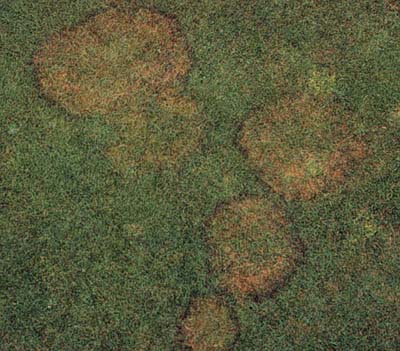Source(s): Paul Pugliese
Brown Patch on turfgrasses is caused by a fungus disease named Rhizoctonia solani.

Appearance
Circular patches of dead grass that range from a few inches to several feet in diameter. Occurs during periods of high humidity and warm temperatures (75ºF to 85ºF). Georgia’s summer climate is ideal for this fungal disease to thrive! Brown areas of dead grass are surrounded by a reddish-brown or purplish halo. After 2 to 3 weeks, the center area of brown grass may recover and turn green resulting in a doughnut shape of dead brown grass.
Hosts
Attacks all turf grasses including Bermuda, Fescue, Centipede, and Zoysia grasses. There are some varieties of these grasses that are “resistant” or less susceptible to the Brown Patch disease but none are totally immune.
Seasons
Prevalent during warm, humid summer months.
IPM
Conditions that favor Brown Patch are:
- Excessive nitrogen fertilizers
- Frequent watering or watering late in the day
- High humidity
Don’t apply excessive nitrogen fertilizers; use only enough to maintain a reasonably healthy green turf. Excessive nitrogen tends to favor the development of Brown Patch due to lush, tender new growth of grass that is most susceptible to attack by the fungus.
Also, watering early in the morning allows the grass foliage to dry before nightfall. Most fungi grow and develop during the night, given adequate moisture. Water lawns early, less often and more deeply!
Mow lawns slightly higher than normal during periods of excessively high heat conditions. This reduces stress to turfgrasses, thus, helping to reduce the possibility of disease .
Comment
If you think you have Brown Patch in your lawn, bring a sample of grass (about 4″ square) with both living and dead tissue to the Extension office for proper diagnosis. A fungicide recommendation may be required if the problem cannot be corrected by cultural or IPM practices.
Resource(s):
Center Publication Number: 45
- Brown Patch - September 22, 2013